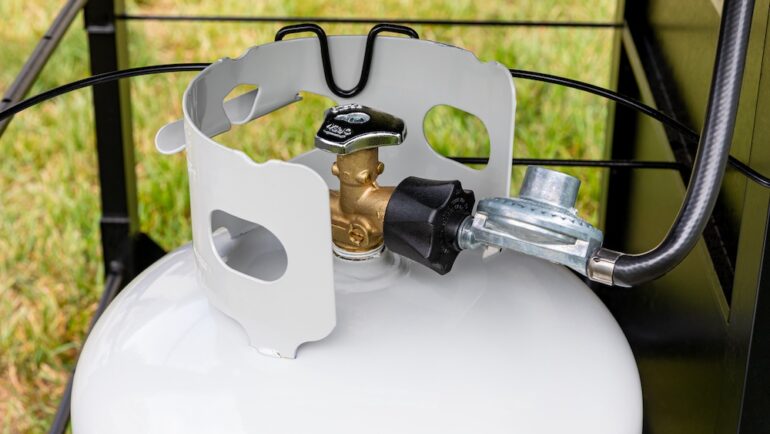Propane is a ubiquitous gas sold in steel bottles—propane tanks—attached to barbecue grills nationwide. Many homes in the country have 250- to 1,000-gallon propane tanks used for heating. Propane is highly beneficial but must be handled safely. Here’s what you need to know.
How to store propane tanks
Propane is an odorless gas converted to liquid form and injected under pressure into steel bottles. In propane processing, an odor is added so a leak can be smelled. On the top of the bottle is a valve that attaches to a hose with a coupling for use in grills or home heating. The bottle includes a pressure-relief valve that activates if the bottle’s pressure exceeds safe limits; this is designed to prevent an explosion. The valve is protected by a sturdy metal collar with handles that prevent it from being accidentally hit.
Here are the essential things you must know about propane tanks’ safe handling and storage.
- Never store propane bottles in a place where they will receive direct, hot sun. The heat can expand the gas in the bottle to a dangerous pressure.
- Do not store propane bottles inside a home, garage, or storage shed.
- The best storage for propane bottles is outside in a shady place. If you are getting a whole-house propane tank, consult with the installer on the best location for the tank.
- A propane bottle should always stand upright and never be placed on its side.
- When transporting a propane bottle, secure it with straps to prevent tipping over en route.
- If a propane bottle is attached to a grill, turn off the bottle valve after grilling. Do not leave the valve in the on position, even if you intend to grill again soon.
- Often, the most cost-effective way to resupply propane is to refill the bottle, not to trade your empty bottle for a full one.
How to check for leaks
Periodically check for leaks around your propane tank’s valve, hose, coupler, and regulator. With the gas connected and turned on at the bottle valve, dribble soapy water at each connection point. Watch for bubbles indicating a leak. If a leak is detected, deal with it right away. If there is damage to the coupler, the hose and coupler can be replaced. If the leak is due to the bottle valve being damaged, close the valve, set the bottle outside in the shade, and contact your refill supplier to help dispose of the bottle correctly. By law, in most states, the bottle must be emptied professionally and then destroyed. A damaged bottle cannot be repaired.
Related – Safety First When Grilling Great Food


